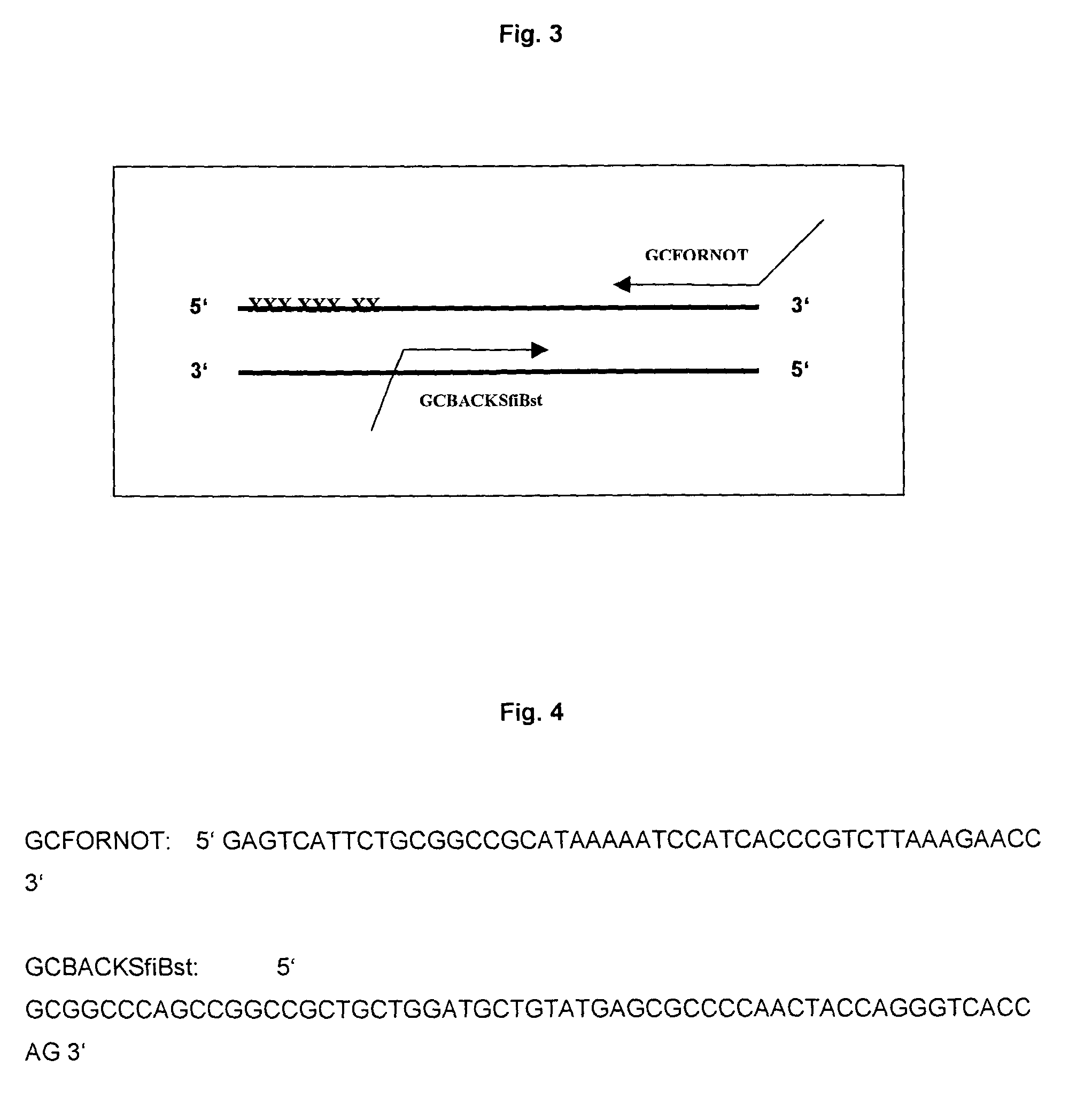[0008]Alteration of the surface of a beta-sheet
protein generates novel
binding properties previously not present in the
protein. These binding properties are generated by
mutagenesis of a beta-sheet region. In
spite of the de novo binding properties, the novel beta-sheet proteins are similar to the starting proteins with respect to structure and stability. Starting proteins for designing the novel binding molecules are proteins with a predominant beta-
sheet structure such as, for example, gamma-crystalline, a
structural protein of the
eye lens. Based on the
crystal structure, regions and amino acids in the beta-sheet of the starting proteins, which are exposed on the surface and thus accessible to the
solvent or possible binding partners, are selected, for example, by means of computer analyses. Using
genetic engineering methods, these regions or
amino acid positions are mutagenized in the
gene coding for the starting
protein. Thus, a multiplicity of mutated genes (
bank or
library) coding for the different beta-sheet proteins mutants are prepared at the
DNA level. Mutants having novel, desired binding properties are isolated with the aid of a suitable
selection system such as, for example, the
phage display system. In
phage display, all protein mutants produced are exposed on the surface of bacteriophages (
phage display library). These recombinant phages are studied with respect to their binding to the desired target molecules. Phages which
expose on their surface beta-sheet mutants with specific binding to the target molecule are concentrated by repeated screening and isolated. Genes coding for binding beta-sheet mutants are obtained from the phages and expressed in a suitable expression system such as, for example, E. coli. Using the method described, it is surprisingly possible to prepare specifically binding proteins from beta-sheet proteins having no specific binding properties whatsoever, and mutants having the desired specificity are isolated from the
library by applying a suitable
screening method. Depending on the properties of the starting proteins, the beta-sheet mutants produced using the system described have advantages regarding size, stability and functionally active production in the
heterologous, preferably bacterial, system, compared with, for example, antibodies and recombinant
antibody fragments. These improved properties of the novel beta-sheet mutants make it possible to replace, for example, antibodies, recombinant
antibody fragments of catalytic antibodies and to open up completely new
application areas.
[0013]A suitable system for isolating mutagenized beta-sheet proteins with de novo binding properties is the phage display system. This system makes possible very efficient screening of a large
repertoire of protein variants for specific binding properties (Smith, 1985). In this connection, a protein variant is in each case presented on the surface of a filamentous phage and can interact with the target molecules immobilized on a
solid phase. Proteins binding to the target molecule can be obtained by eluting the phages. After isolating the phage
DNA, the
DNA sequence of the specifically
binding protein variants can be determined. In addition to the phage display system, it is also possible to apply other selection systems such as, for example, bacterial
surface display (Stahl and Uhlen, 1997) or
ribosome display (Hanes et al., 1997).
[0032]Preference is given to using for expression and selection the phage display system in which all mutants produced at the DNA level are cloned into a
phagemid and expressed on phage surfaces. In the case of proteins containing reduced cysteines, it is possible, in a particularly preferred embodiment of the invention, to add GSH, in order to improve exposition and selection of the mutants.
[0040]For example in
bacteria, obtaining the supernatant and testing for the desired enzymic activity to be selected (You and Arnold, 1996). The present invention thus solves the problem of generating proteins having new binding properties or new catalytic properties by mutagenizing proteins with beta-sheet structures in this
structural motif. Those proteins are selected for, which possess the desired new or altered, preferably improved binding properties or the desired new or altered, preferably improved, enzymic or catalytic activities. The system of the invention even makes it possible to alter beta-sheet proteins which have no binding properties or no enzymic properties such that, after mutagenization in the beta-sheet, they acquire binding properties or catalytic properties.
[0048]The method of the invention makes it possible to prepare an indeed enormous number of mutants.
Mutagenesis of just eight
amino acid positions makes it possible to form 2.6×1010 different
protein species which can be analysed for the desired binding properties and catalytic activities.
[0050]The mutated genes obtained can be propagated in suitable systems and the proteins can be expressed. Suitable expression systems are prokaryotic or eukaryotic systems. The DNA coding for the
mutated protein is transferred, for example, into a suitable vector, for example into an
expression vector, and introduced into a host
cell by transformation,
transfection or infection. The linkage to regulatory sequences which specifically control expression of the
heterologous mutated DNA is advantageous, of course.
 Login to View More
Login to View More 


